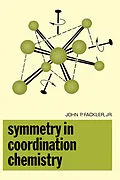Symmetry in Coordination Chemistry provides a comprehensive discussion of molecular symmetry. It attempts to bridge the gap between the elementary ideas of bonding and structure learned by freshmen, and those more sophisticated concepts used by the practicing chemist. The book emphasizes the use of symmetry in describing the bonding and structure of transition metal coordination compounds. The book begins with a review of basic concepts such as molecular symmetry, coordination numbers, symmetry classification, and point group symmetry. This is followed by separate chapters on the electronic, atomic, and magnetic properties of d-block transition elements; the representation of orbital symmetries in a manner consistent with the point group of a molecule. Also included are discussions of vibrational symmetry; crystal field theory, ligand field theory, and molecular orbital theory; and the chemistry of a select few d-block transition elements and their compounds. This book is meant to supplement the traditional course work of junior-senior inorganic students. It is for them that the problems and examples have been chosen.
Inhalt
Preface
Acknowledgments
1. Molecular Symmetry and Point Groups
Molecular Symmetry
Coordination Numbers
Symmetry Classification
Symmetry Point Groups
Multiplication of Symmetry Operations
Point Group Symmetry
Supplementary Reading
2. Atomic and Electronic Properties of d-Block Transition Elements
Transition Elements
Periodic Build-up
Electronic Properties of the Atoms and Ions
Energy Considerations
Atomic Spectra
Russell-Saunders Classification
Magnetic Properties
Supplementary Reading
3. Orbital Symmetries and Their Representation
Orbital Symmetry
Representations of Symmetry
Reducible Representations
Reduction of Reducible Representations
Supplementary Reading
4. Symmetry Applied to Molecular Vibrations
Representing Vibrational Symmetry
Types of Molecular Vibrations
Selection Rules
Infrared-Active Vibrations
Structural Conclusions
Supplementary Reading
5· Chemical Bonding in Transition Metal Compounds
Crystal Field Theory
Ligand Field Theory
Molecular Orbital Theory
Supplementary Reading
6. The d-Block Transition Elements and Their Chemistries
First Transition Series
Jahn-Teller Behavior
Second and Third Transition Series
Miscellaneous Coordination Compounds
Appendix Some Important Character Tables
Subject Index
